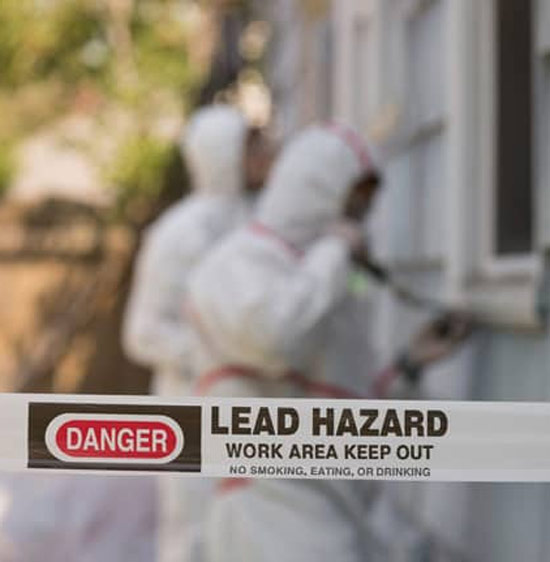NYC Lead Removal Contractors-- Get Safe and Efficient Services
NYC Lead Removal Contractors-- Get Safe and Efficient Services
Blog Article
Best Practices for Making Sure Safe and Thorough Lead Infraction Reduction
Dealing with lead offense abatement needs a multi-faceted approach to ensure both security and conformity. Initial evaluations making use of advanced detection techniques such as XRF analyzers established the stage for an accurate understanding of contamination degrees. Including proper containment methods, consisting of airtight barriers and HEPA filtering, combined with making use of personal protective devices (PPE) for employees, creates the backbone of a protected operation. Careful cleaning methods, featuring HEPA vacuuming and wet-wiping, are critical. It's the last clearance procedure, entailing thorough inspections and laboratory testing, that truly confirms a lead-free environment, ensuring long-term safety. Just how do these techniques adjoin to assure detailed lead reduction?

First Analysis
Performing a first evaluation is an essential primary step in lead infraction abatement. This stage includes an in-depth examination of the building to recognize the existence, extent, and details locations of lead-based risks. Certified experts, such as licensed lead inspectors or risk assessors, must perform a detailed site assessment, utilizing tools like X-ray fluorescence (XRF) analyzers to properly discover and gauge lead concentrations in paint, dirt, dirt, and water.
The assessment needs to additionally include an evaluation of the structure's history, previous records, and any kind of grievances or health and wellness concerns reported by passengers - Lead Removal Contractors. Recording the findings thoroughly is crucial, as these records develop the basis for creating a reliable abatement technique. A detailed assessment likewise includes tasting and research laboratory analysis, which are vital to verify the visibility of lead and overview succeeding actions
Additionally, it is imperative to communicate the results transparently to all stakeholders, including homeowner, lessees, and regulatory authorities. By ensuring that the initial evaluation is carried out with precision and rigor, experts can lay a solid foundation for a targeted and efficient lead abatement process, ultimately safeguarding public health and guaranteeing compliance with regulatory standards.
Proper Control
Appropriate containment is critical to stop the spread of lead contaminants throughout abatement activities. Properly handling control lessens the risk of lead dirt and debris moving to non-work areas, therefore securing both the environment and people outside the immediate job zone.

Regular evaluations of the control area are needed to check for violations or weak points in the barrier. Any kind of determined concerns ought to be promptly resolved to maintain the stability of the control. By sticking to these methods, abatement projects can effectively regulate lead contamination and minimize associated health and wellness threats.
Worker Defense
Ensuring worker defense is paramount throughout lead reduction home projects to avoid job-related exposure to dangerous lead bits. Essential steps consist of using personal protective devices (PPE) such as respirators, handwear covers, and full-body matches specifically developed to block lead dirt and fumes. Employees need to undergo extensive training on the right use and upkeep of PPE, consisting of healthy screening for respirators to ensure maximum effectiveness.
Engineering controls, such as regional exhaust air flow systems, are vital in decreasing air-borne lead focus in the work environment. Administrative controls should also be executed, including limiting the duration of exposure and rotating workers to reduce individual direct exposure times. Normal clinical security and organic surveillance are crucial for very early discovery of lead absorption, allowing timely intervention and treatment.
Furthermore, developing a decontamination method is essential. Employees need to comply with strict decontamination treatments prior to breaks and at the end of their change to avoid lead dust from being carried outside the job location. This includes complete hand and face cleaning with lead-specific cleaning representatives and transforming out of polluted clothes.
Meticulous Cleaning
Keeping a risk-free workplace prolongs beyond employee security and encompasses thorough clean-up to guarantee lead particles are extensively eliminated from the website. The procedure of precise cleaning is important in avoiding the recontamination of the abated location and protecting both existing and future passengers.
To achieve a thorough cleanup, all workspace must be methodically decontaminated. This entails making use of specialized HEPA (High-Efficiency Particulate Air) hoover and wet-wiping methods to capture and eliminate great lead dust that might have worked out on surface areas. It is crucial to clean all straight surface areas, including floorings, home window sills, and counter tops, along with vertical surfaces that might have trapped lead bits.
Employees must use ideal personal protective devices (PPE) throughout cleanup to prevent direct exposure to residual lead dust. Utilized cleansing materials such as wipes, sponges, and mop heads must be disposed of based on harmful waste disposal regulations.

Final Clearance
Final clearance is the important wrapping up stage of lead abatement that figures out whether the site is risk-free for reoccupation. This important action includes detailed assessment and testing to confirm that all lead risks have been effectively eliminated.

Last clearance testing not only shields future passengers however also makes certain conformity with local, state, and government guidelines. It offers as a documented recognition of the abatement contractor's adherence to sector finest techniques. Making sure a comprehensive and effective final clearance is essential in securing public health and cultivating rely on the reduction process.
Final Thought
Ensuring risk-free and comprehensive lead offense abatement requires a complex method incorporating initial evaluations with advanced detection approaches, effective containment approaches, strict employee defense protocols, and careful cleanup procedures. The last clearance phase, featuring in-depth examinations and lab screening, is crucial to verify conformity with EPA standards. Adherence to these best practices ensures a secure environment for residents, alleviates wellness threats, and upholds regulative demands, consequently advertising public wellness and safety in lead-affected areas.
Report this page